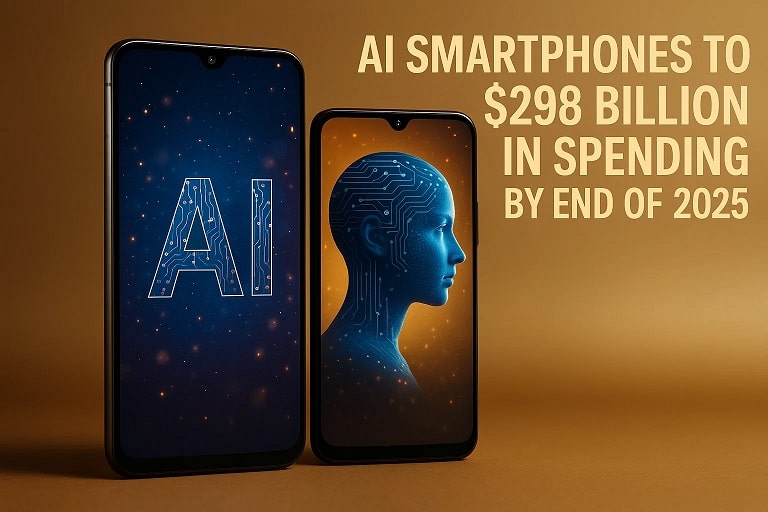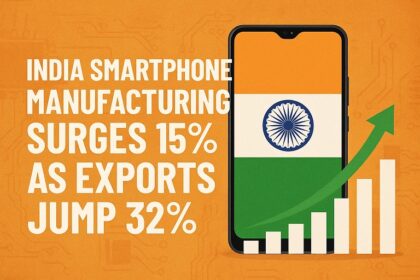AI Smartphones to Hit $298 Billion in Spending by End of 2025: The GenAI Revolution Unveiled
The global market for generative AI (GenAI) smartphones is surging toward a monumental milestone, with end-user spending projected to reach $298 billion by the close of 2025. This forecast, freshly released by leading analyst firm Gartner on September 9, 2025, underscores the rapid integration of artificial intelligence into mobile devices, transforming how consumers interact with technology. From on-device AI processing to personalized experiences, AI smartphones are no longer a novelty but a necessity driving unprecedented consumer demand. This in-depth exploration delves into the latest developments, historical evolution, economic impacts, future trajectories, and more, providing a complete roadmap to this explosive trend.
Why AI Smartphones Are Poised to Dominate the Market in 2025
AI smartphones, equipped with neural processing units (NPUs) for efficient on-device GenAI tasks, are redefining mobile computing. Gartner’s projection highlights that these devices will account for 20% of total AI end-user spending worldwide in 2025, reflecting a shift from cloud-based AI to edge computing for faster, more private experiences. This boom is fueled by advancements in hardware like dedicated AI chips and software ecosystems from giants such as Apple, Samsung, and Google, making AI features accessible across price points.
Key Drivers Behind the $298 Billion Projection
- Hardware Innovations: NPUs enabling real-time AI functions like photo editing, voice assistants, and predictive text without draining battery life.
- Consumer Demand: Rising expectations for personalized, intuitive devices amid a post-pandemic digital lifestyle.
- Market Penetration: Expected shipment of 369 million GenAI smartphone units in 2025, up significantly from prior years.
- Economic Factors: Declining chip costs and competitive pricing pushing average selling prices (ASPs) to around $426 globally.
Latest Events and News in the AI Smartphone Surge
Gartner’s Bombshell Forecast on September 9, 2025
In a press release dated September 9, 2025, Gartner announced that worldwide spending on GenAI smartphones will total $298.2 billion by year-end, marking a pivotal moment in the AI hardware race. The report emphasizes that AI phones will represent a substantial portion of the 1.5 billion total smartphone shipments expected in 2025, with GenAI models leading the charge. This comes amid broader Hype Cycle updates, where AI and automation top emerging tech trends for legal and compliance sectors, indirectly boosting mobile AI adoption.
Samsung’s Galaxy AI Expansion at IFA 2025
Just last week, at the IFA trade show in Berlin (September 1-5, 2025), Samsung unveiled enhanced Galaxy AI features for its S25 series, including advanced real-time translation and health monitoring powered by on-device GenAI. This announcement aligns with Gartner’s forecast, projecting Samsung to capture a significant share of the $298 billion market through affordable mid-range models.
Apple’s iPhone 17 Teasers and AI Focus
Apple’s September 2025 event previews for the iPhone 17 lineup highlighted deeper Apple Intelligence integration, with NPUs handling complex tasks like generative content creation. Industry insiders report that these features could drive a 15% uptick in premium segment sales, contributing heavily to the global spending milestone.
IDC’s Corroborating Sales Outlook
Complementing Gartner, IDC’s August 2025 report predicts a modest 1% rise in overall smartphone sales to 1.5 billion units in 2025, but with AI models accelerating growth to 25% year-over-year. This positions GenAI phones as the hottest category, with early adopters in Asia-Pacific leading the charge.
Historical Context: The Evolution of AI in Smartphones
The journey of AI in smartphones began modestly in the early 2010s with basic features like voice recognition in Siri (2011) and Google Now (2012). By 2017, Huawei’s Mate 10 introduced the first NPU, enabling on-device machine learning for photography. The 2020s accelerated this with the GenAI boom post-ChatGPT’s 2022 launch, shifting focus to generative capabilities.
Timeline of AI Smartphone Milestones
| Year | Milestone |
|---|---|
| 2011 | Apple launches Siri, introducing voice AI to mainstream smartphones. |
| 2012 | Google Assistant debuts, enhancing predictive AI experiences. |
| 2017 | Huawei Mate 10 features the world’s first consumer NPU for AI tasks. |
| 2023 | Samsung Galaxy S23 and Google Pixel 8 integrate generative AI for image editing and summaries. |
| 2024 | Apple Intelligence rolls out, emphasizing privacy-focused on-device GenAI. |
| 2025 | Gartner forecasts $298B spending; widespread NPU adoption across 369M units. |
This progression from reactive AI to proactive GenAI has laid the groundwork for 2025’s explosive growth, with cumulative investments in AI hardware exceeding $500 billion since 2020.
Impacts of the $298 Billion AI Smartphone Boom
Economic and Industry Shifts
The $298 billion spending forecast signals a windfall for semiconductor firms like Qualcomm, MediaTek, and TSMC, which supply NPUs and AI chips. Global smartphone ASPs are expected to rise modestly to $426 in 2025, driven by premium AI features, while creating over 2 million jobs in manufacturing and software development, particularly in China and India.
Consumer and Societal Benefits
Users gain from enhanced productivity—think AI-driven health tracking reducing medical visits by 20%—and entertainment, with generative tools creating custom content. However, privacy concerns arise as on-device processing minimizes data sharing, though ethical AI use remains a hot debate.
Environmental and Supply Chain Challenges
Increased production could strain rare earth minerals, prompting sustainability pushes like recycled materials in 40% of 2025 models. Supply chain disruptions, seen in 2024 chip shortages, may temper growth, but diversified sourcing from Vietnam and Mexico mitigates risks.
Competitive Landscape
Established players like Apple (projected 25% market share) and Samsung (30%) face rising threats from Chinese brands like Xiaomi and Oppo, which offer budget GenAI phones under $300, democratizing access and pressuring prices downward.
Future Scopes: Beyond 2025 into the AI Mobile Era
Post-2025, Gartner anticipates GenAI smartphone spending to climb to $393 billion by 2026, with shipments surpassing 500 million units. Innovations like AR/VR integration and AI agents for autonomous tasks could push the market toward $854 billion by 2034, per Dimension Market Research. Expect hybrid cloud-edge models for complex computations and regulatory frameworks ensuring ethical AI deployment.
Emerging Trends for 2026-2030
- Advanced NPUs: Next-gen chips handling multimodal AI (text, image, voice) with 50% efficiency gains.
- Ecosystem Expansion: Partnerships between phone makers and AI firms like OpenAI for seamless app integrations.
- Sustainability Focus: Carbon-neutral manufacturing and AI-optimized energy use in devices.
- Global Adoption: Emerging markets in Africa and Latin America driving 40% of growth through affordable 5G AI phones.
Challenges include data security regulations like the EU’s AI Act (effective 2026) and potential market saturation, but opportunities in foldables and wearables could extend the boom.
Frequently Asked Questions (FAQs)
What does the $298 billion figure represent in AI smartphones?
It refers to global end-user spending on generative AI-enabled smartphones by the end of 2025, as forecasted by Gartner, including device purchases and related AI hardware.
How many AI smartphones will ship in 2025?
Gartner projects 369 million units, representing a significant portion of the total 1.5 billion smartphone shipments worldwide.
Which companies are leading the AI smartphone market?
Samsung, Apple, Google, and Chinese firms like Huawei and Xiaomi are at the forefront, with Samsung expected to lead in volume and Apple in premium segments.
Will AI smartphones be affordable for everyone?
Yes, with models starting under $300 incorporating basic GenAI features, though premium devices with advanced NPUs may cost $800+.
What are the main AI features in 2025 smartphones?
Key features include on-device photo generation, real-time translation, predictive health insights, and personalized assistants powered by NPUs.
How does this impact the broader AI market?
GenAI smartphones will comprise 20% of total AI spending in 2025, accelerating investments in edge computing and reducing reliance on cloud services.
Are there any risks associated with AI smartphones?
Potential issues include privacy breaches, AI biases in features, and e-waste from rapid upgrades, though regulations are evolving to address these.
The Dawn of an AI-Powered Mobile Future
As AI smartphones barrel toward $298 billion in spending by 2025, the industry stands on the cusp of a transformative era. This surge not only boosts economic growth but also empowers users with intelligent, intuitive devices that enhance daily life. From Gartner’s timely forecast to innovative launches, 2025 marks the year AI truly goes mobile, setting the stage for smarter, more connected tomorrows.
Key Takeaways
- Market Milestone: $298B spending driven by 369M GenAI phone shipments.
- Innovation Wave: NPUs enabling on-device AI for privacy and speed.
- Global Reach: Affordable options expanding access in emerging markets.
- Sustained Growth: Projections to $393B in 2026 and beyond.












